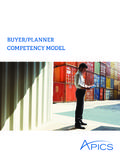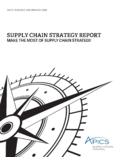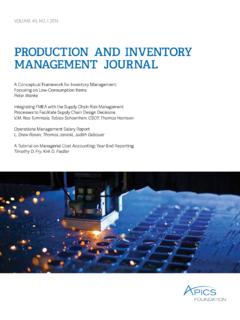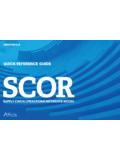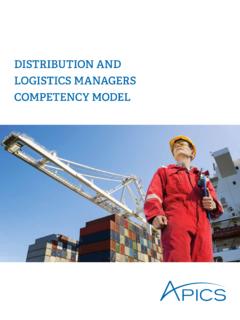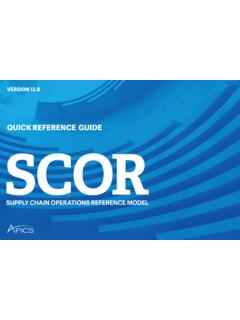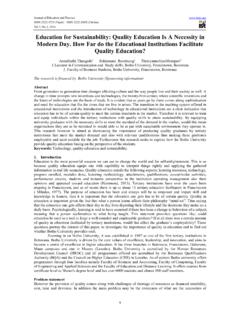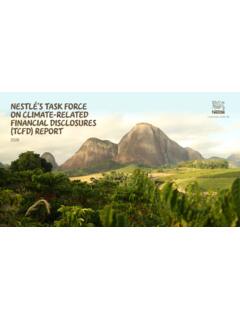Transcription of SUPPLY CHAIN SUSTAINABILITY - ASCM
1 SUPPLY CHAIN SUSTAINABILITYUNCOVERING THE TRIPLE BOTTOM LINEAPICS INSIGHTS AND INNOVATIONSS ustainability practices are evolving and becoming more integrated with other traditional SUPPLY CHAIN and operations processes. APICS wanted to learn more about SUSTAINABILITY practices at organizations and in August and September 2011, invited more than 9,000 SUPPLY CHAIN professionals to share their perspectives and insights. APICS conducted a survey to investigate the differing levels of experience and maturity that go into SUSTAINABILITY practices, and what those practices bring to organizations. The survey results reflect an approximate four percent margin of error at a 95 percent confidence report was developed by APICS SUPPLY CHAIN Council, an organization that advances SUPPLY CHAIN and operations management and innovation through research, education and publications. APICS SCC maintains the SUPPLY CHAIN Operations Reference (SCOR) model, the SUPPLY CHAIN management community s most widely accepted framework for evaluating and comparing SUPPLY CHAIN activities and performance.
2 For more information, visit SCC research reports are based on practitioner surveys that explore trending topics in SUPPLY CHAIN and operations management. They include survey results, analysis, tips and best practices to keep you and your organization informed of insights and innovations in SUPPLY CHAIN and operations THIS REPORTAPICS INSIGHTS AND INNOVATIONS SUPPLY CHAIN SUSTAINABILITY3 TABLE OF CONTENTSE xecutive Summary 5 APICS Research 43 Perspectives from APICS Magazine From End to End 22 Guiding new product development with life cycle assessmentsThe APICS Interview SUSTAINABILITY concerns increasingly guide the creation and the deployment of new products and services. Procter & Gamble SUSTAINABILITY expert Annie Weisbrod spoke with APICS magazine about the company s SUPPLY CHAIN initiatives, life cycle analyses, carbon footprinting and new product development. The Green Warehouse 28A significant step towards sustainabilityBy Giuseppe Lovecchio, CFPIM, CSCP, CMCP icking and handling activities represent the largest energy consumption in a warehouse and thus the greatest opportunity for green advancement.
3 Innovation Over Carbon Ideology 34 Cut waste the right wayBy William A. Levinson, CFPIML earn how to identify what adds value and whatdoesn t in order to reduce overall the Garden Path 38 Easing your company into a sustainable energy programBy Tim BeckerProceed deliberately when formulating and executing green strategies. The most successful initiatives are focused and carefully designed, and they conform to well-established business CHAIN SUSTAINABILITYUNCOVERING THE TRIPLE BOTTOM LINEAPICS INSIGHTS AND INNOVATIONS4 SUPPLY CHAIN SUSTAINABILITYUNCOVERING THE TRIPLE BOTTOM LINEAPICS POINT OF VIEWS ustainability: The APICS Dictionary, 14th Edition, defines SUSTAINABILITY as activities that provide present benefit without compromising the needs of future generations. APICS INSIGHTS AND INNOVATIONS4 SUPPLY CHAIN SUSTAINABILITY5 EXECUTIVE SUMMARYIn 2011, APICS conducted a survey of SUPPLY CHAIN and operations management professionals around the world to investigate the differing levels of experience and maturity that go into SUSTAINABILITY practices, and what those practices bring to survey revealed the following SUSTAINABILITY trends: The concept of SUSTAINABILITY is not consistent from senior management to the shop floor.
4 A senior manager views SUSTAINABILITY in a strategic way, considering issues such as organizational planning, alignment, goals, options and priorities. On the shop floor, it is more difficult to distinguish SUSTAINABILITY from the day- to-day tactics and key performance indicators that define ongoing tasks. Successful SUPPLY CHAIN SUSTAINABILITY requires good SUPPLY CHAIN strategy and the capability to implement it. Triple bottom line SUPPLY CHAIN SUSTAINABILITY , or TBL, is a measure of SUSTAINABILITY that includes social, environmental and financial performance measures people, planet and profit and helps ensure that there is a long-term SUPPLY of people, natural resources and profit. Triple bottom line SUSTAINABILITY tends to see differences in priority, but most often people and profitably are placed ahead of planet. The most essential ingredient for success is senior management leadership. Senior managers have a powerful influence on the adoption rate of SUPPLY CHAIN SUSTAINABILITY practices, the method of practice, and how effectively the practice is integrated in the SUPPLY CHAIN and across the is EvolvingSustainability is becoming better defined vertically within an organization, and better defined horizontally in terms of metrics, measurements and standards globally across industries.
5 SUSTAINABILITY is becoming more integrated with other traditional SUPPLY CHAIN operations processes due to related innovation, new technologies, new processes and stakeholder preferences. Lean management and SUSTAINABILITY are a natural combination, but there will be further innovation in the way service standards or supplier performance integrates with INSIGHTS AND INNOVATIONS6 Advancing SUSTAINABILITY at Your OrganizationTo advance SUSTAINABILITY at your organization, take the following steps: Clarify, define and execute a consistent definition of SUSTAINABILITY that spans all employee levels, from senior management to the shop floor. Align SUPPLY CHAIN strategy and tactics to support the business unit or organizational strategy in terms of SUSTAINABILITY , including long-term decisions, measurements, investments and process improvements. Advance SUPPLY CHAIN maturity practice through continuous improvement. Prioritize the most impactful changes, investments, metrics and standards when making decisions, and make sure SUSTAINABILITY remains as visible as it needs to be across the SUPPLY the Triple Bottom LineMore and more, business people are talking about something called triple bottom line SUSTAINABILITY , or TBL, a framework comprised of three pillars: social, environmental and financial , or the three Ps: people, profit and planet.
6 Corporate social responsibility is colliding with government regulation and customer desire and pressing decision makers to consider how their SUPPLY CHAIN actions influence these three areas. As the United Nations Secretary-General Ban Ki-moon said, We can and must shape a future where robust markets, sustainable development and a healthy planet become the new status quo. The practice of SUPPLY CHAIN SUSTAINABILITY incorporating triple bottom line results into SUPPLY CHAIN decisions ultimately relies on the values of SUPPLY CHAIN practitioners, their organizations, and their SUPPLY chains to define and develop specific sustainable activities. Increasingly, well-defined standards, industry best practices and published guidance are combining to advance SUPPLY CHAIN SUSTAINABILITY around the world. We can and must shape a future where robust markets, sustainable development and a healthy planet become the new status quo. Secretary-General Ban Ki-moon SUPPLY CHAIN SUSTAINABILITY7 Sustaining and Maximizing Your SUPPLY CHAIN The APICS Dictionary, 14th Edition, defines SUSTAINABILITY as activities that provide present benefit without compromising the needs of future generations.
7 Sometimes the idea of SUSTAINABILITY is expressed as, Take care of yourself, take care of others, and take care of the planet. In practice, SUPPLY CHAIN SUSTAINABILITY interacts with almost every SUPPLY CHAIN component, whether in simple or complex SUPPLY chains. SUPPLY CHAIN SUSTAINABILITY practice should be a consideration in decisions involving strategy, tactics, goals, processes, trade-offs and outcomes in all levels of SUPPLY CHAIN management. In fact, senior management is by far the best single influence to SUPPLY CHAIN SUSTAINABILITY practice. The customer is the second largest influence, and employees are the third largest influence. Triple bottom line SUSTAINABILITY may intersect with risk or strategy practice in addressing long-term uncertainty in the availability of people, markets and resources necessary for lasting business CHAIN SUSTAINABILITY is still a relatively new idea. Variation in levels of adoption, maturity, metrics and management differ by nation, industry and company.
8 Within SUPPLY chains, partner relationships are often insufficiently integrated for optimal interaction. Nonetheless, SUPPLY chains designed to combine rising profit and falling customer costs, while resulting in higher living standards and lower environmental costs, are creating new best the past, the desirable outcomes of more profit and higher living standards for people (based on falling costs or more availability of goods and services) sometimes came at the expense of rising costs to the planet or in rising costs to people in other ways (inadequate employee standards or customer service, for example). That is not an ideal bargain. To achieve rising profit and higher living standards, and at the same time reduce environmental and customer costs, requires excellence in SUPPLY CHAIN and operations management practice. In other words, it takes the very best of SUPPLY CHAIN practice to advance people, planet and INSIGHTS AND INNOVATIONS8 The SUSTAINABILITY PushSurvey respondents revealed that the motivations for incorporating SUPPLY CHAIN SUSTAINABILITY practices into an organization s overall strategy are increasing.
9 These motivating factors include: Brand management and reputation Cost reduction Revenue growth Customer demand Employee recruitment Government regulation Investor or shareholder expectationsRespondent organizations were compared by sustainable business practices implemented for different lengths of time. The study uncovered one essential ingredient for success: senior management leadership. Senior managers influence the adoption rate of SUPPLY CHAIN SUSTAINABILITY practice, the method of practice, and organizational and related SUPPLY CHAIN strategy integration. Senior managers also provide vital leadership through such means as business values, mission statements and organizational strategy. Organizations that have practiced SUSTAINABILITY longer tend to identify these areas as most critical when compared to other organizations with less SUSTAINABILITY , gaps may develop between senior managers and SUPPLY CHAIN professionals, and these disparities may inhibit SUPPLY CHAIN SUSTAINABILITY maturity.
10 The reason is that individual business units sometimes are most responsible for adherence to SUSTAINABILITY policy compared to individuals, teams or departments. SUPPLY CHAIN SUSTAINABILITY9 Consider the following table, which summarizes the responses from SUPPLY CHAIN practitioners regarding the most and least critical elements to achieve maturity in SUPPLY CHAIN SUSTAINABILITY . lSenior management leadershipEarly adopterMy organization has had a policy for 15 years or moreMiddle adopter My organization established its policy between five and 15 years agoRecent adopterMy organization has had a policy for less than five yearsMost critical13% critical0% values and mission statementEarly adopterMy organization has had a policy for 15 years or moreMiddle adopter My organization established its policy between five and 15 years agoRecent adopterMy organization has had a policy for less than five yearsMost SUSTAINABILITY strategiesEarly adopterMy organization has had a policy for 15 years or moreMiddle adopter My organization established its policy between five and 15 years agoRecent adopterMy organization has had a policy for less than five yearsMost 7.
